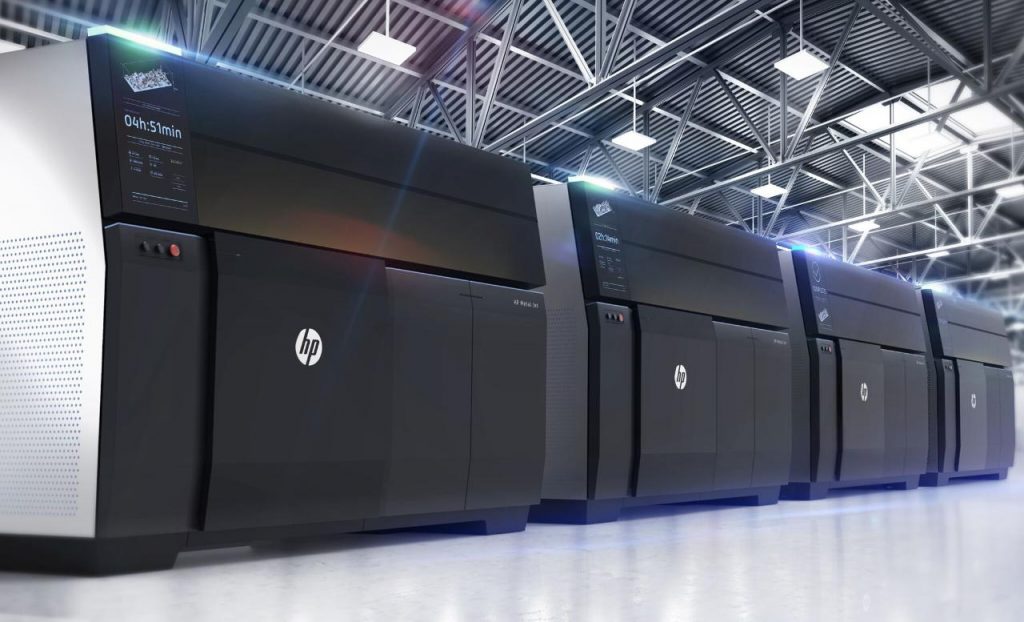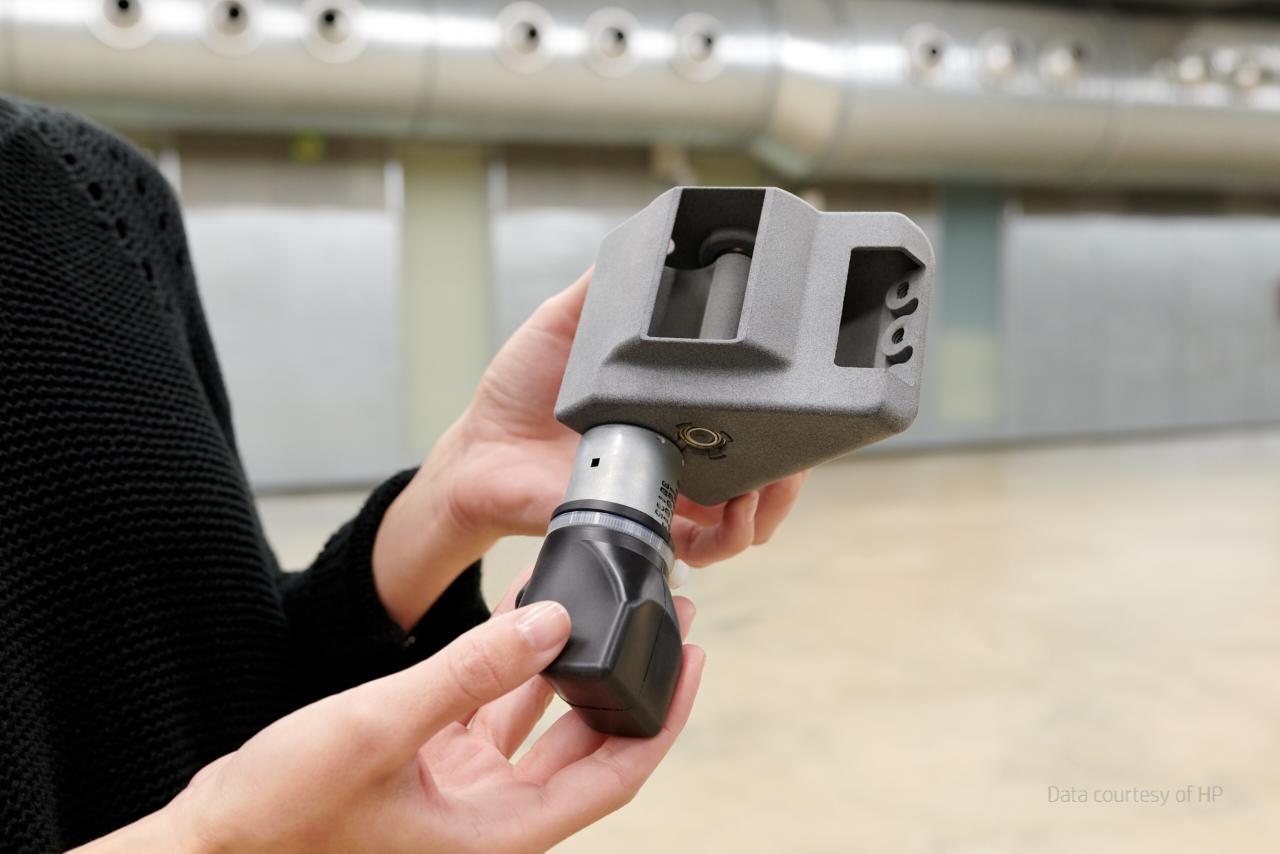 Hewlett-Packard has been around for 80 years. Started in a Palo Alto garage by William Hewlett and David Packard, it defined much of Silicon Valley’s culture, making the region a world renown hub for electronics. The company was always driven by the need to be at the forefront of industrial development throughout its history. It was the same when 3D printing technology came along and HP announced in 2015 that they were going to enter the additive manufacturing industry and just months later launched their first 3D printers based on their unique, patented technology, known as Multi Jet Fusion, which enables customers to produce complex parts with controllable physical and functional properties at each point and provides speed, quality, and strength throughout the manufacturing process for a range of industries and applications. They built upon this success with last September’s launch of a new metals 3D printing technology for mass production, the HP Metal Jet. The new Metal Jet platform means that customers can reduce the cycle time for the production of parts and realize a higher volume of mass production quickly. HP’s growing 3D portfolio allows customers to take on new jobs and unlock new revenue streams, broadening their capabilities. 3DPrint.com spoke to Ramon Pastor, VP and General Manager of HP’s 3D Printing Business, about the firm’s future as one of the most viable alternatives in 3D printing technology.
Hewlett-Packard has been around for 80 years. Started in a Palo Alto garage by William Hewlett and David Packard, it defined much of Silicon Valley’s culture, making the region a world renown hub for electronics. The company was always driven by the need to be at the forefront of industrial development throughout its history. It was the same when 3D printing technology came along and HP announced in 2015 that they were going to enter the additive manufacturing industry and just months later launched their first 3D printers based on their unique, patented technology, known as Multi Jet Fusion, which enables customers to produce complex parts with controllable physical and functional properties at each point and provides speed, quality, and strength throughout the manufacturing process for a range of industries and applications. They built upon this success with last September’s launch of a new metals 3D printing technology for mass production, the HP Metal Jet. The new Metal Jet platform means that customers can reduce the cycle time for the production of parts and realize a higher volume of mass production quickly. HP’s growing 3D portfolio allows customers to take on new jobs and unlock new revenue streams, broadening their capabilities. 3DPrint.com spoke to Ramon Pastor, VP and General Manager of HP’s 3D Printing Business, about the firm’s future as one of the most viable alternatives in 3D printing technology.
“We’re seeing four key forces at play in the global economy: rapid urbanization, changing demographics, hyper-globalization and accelerated innovation. The result has been a constantly changing playing field for businesses everywhere, but there’s an underlying opportunity to break out of the old ways of working and to invest in production capabilities for the future.The multinational company has bet heavily on 3D printing and HP’s 3D printing portfolio and IP have already demonstrated real value for all kinds of industries, from prototyping through to distributed production and on-demand manufacturing. As we see more customers scale for production and further collaboration through a growing ecosystem of partners, the possibilities are growing for a new era of manufacturing,” claims Pastor.
The new HP Jet Fusion 5200 Series 3D printing solution is the latest example of innovation in this regard. The new solution hopes to expand manufacturing predictability with high-quality and optimal-yield parts at industrial levels of efficiency, accuracy, and repeatability. The new HP Jet Fusion 5200, announced less than two weeks ago is a step in that direction.
“3D printing technology isn’t new, but the scope of its potential applications has grown tremendously in just a few years. We’re already seeing it impact major industries from automotive to healthcare to heavy industry, and huge global brands are beginning to reinvent their businesses for the digital manufacturing future. Recently, a combination of advances in HP’s Multi Jet Fusion technology, the development of new materials, and breakthrough economics driven by their collaborative open materials platform have democratized the technology and made the promise of industrial 3D manufacturing a growing reality. This is a big leap from when 3D printing was solely used for prototyping. The question isn’t if 3D printing will be the new platform for global mass-production, it’s when. And production is just one piece of it. There are also digital revolutions happening in design, distribution, sustainability, and the whole of the entire end-to-end manufacturing process that are enabling companies to innovate faster, leverage flexible manufacturing, reinvent supply chains, create new markets, and produce new things in new ways that were previously impossible,” said Pastor.
Pastor knows HP really well, having joined the company in 1992, and believes that “we’re really just scratching the surface of the benefits this will bring to business and society worldwide.” The World Economic Forum recently estimated the value of digital transformations in the Fourth Industrial Revolution at $100 trillion over the next 10 years alone, across all sectors, industries, and geographies. “It’s truly mind-boggling,” suggests Pastor, who expects that “timely service and hands-on partnership” are critical to maintaining uptime and overall efficiency. Additionally, “HP is unique in the depth of our installation, training, and market-leading application expertise.” Called the HP Ramp Up Service, they work hands-on onsite with new or expanding HP Jet Fusion customers to prepare teams to get the most efficient and effective 3D parts production, tailored to each specific application.
https://youtu.be/VXntl3ff5tc
“While the possibilities of additive manufacturing are near limitless, there are trade strategies to help teams realize optimal production out of the gate. With our team’s knowledge, we help customers optimize 3D printer performance, throughput, part quality and yield at an early stage. Second – and equally as critical – is HP’s level of support. We offer next-business-day onsite support and next-business-day spare-parts availability, thanks to our global reach,” he added.
According to Pastor, traditional manufacturing was ripe for disruption. There were long development cycles; immense production minimums for even the smallest part; cumbersome and resource-intensive distribution networks for raw and finished goods, as well as significant hurdles to making even the smallest design modifications. “Traditional manufacturing evolved to be large but didn’t exactly evolve to be smart. Now, 3D printing completely reinvents the way things are conceived, designed, produced and distributed, significantly lowering development and production costs, immensely simplifying logistics, and lowering carbon footprint. The work being done by Jaguar Land Rover as they advance EV development, or Vestas, the largest provider of wind turbines in the world, are significant examples of how 3D printing is enabling industries to move seamlessly from prototyping to production, with incredible flexibility to make improvements in near real time.” The adoption of HP’s Jet Fusion 5200 by both Jaguar and Vestas underscores the continued shift towards additive manufacturing on a truly industrial scale, rapidly developing and driving piece costs to levels that are starting to become viable alternatives for low volume production.
Also HP’s Barcelona Campus General Manager, Pastor explained automation is an important component of growing to industrial scale AM. So with the Jet Fusion 5200, HP is introducing new data intelligence software and capabilities, which include the HP 3D Process Control and HP 3D Centre software offerings and the HP 3D Parts Assessment service. These integrate data from across the full production footprint into an easy-to-use interface allowing users to enhance automation, monitor in real time, achieve new heights of operational efficiency and repeatability, and identify and optimize production of new 3D applications.
But as additive manufacturing is increasingly adopted by companies and manufacturers, they will face some challenges in implementing the technology. For Pastor, the most significant hurdle is the mindset change.
“It is critical to think about designing for additive from the first stages of product development, to think about the wider implications of how development is staged to full-scale production, and how supply chains can be further optimized. There is a deep, ingrained sense of limits and hurdles for those who have worked decades in traditional manufacturing. With additive manufacturing, there is almost a relearning process that needs to take place – the vast majority of those limits no longer apply. The design possibilities are limitless. And, of course, there are new skills that must be developed to fully leverage these possibilities. For engineers, new elements of the design process will be introduced into their roles where they will need to learn the mechanics of 3D printing to become experts in the processes and best support operational functions during production.”
So, what will the next trend be? The Spanish expert claims that we will see the accelerated impact of digital manufacturing take hold in the form of production applications, particularly across the automotive, industrial and medical sectors.
“In the auto sector, we’ve seen an increased focus on developing production-grade materials for auto applications as 3D printing gravitates from prototyping to full production of final parts and products,” he concluded.
And as new platforms such as electric vehicles enter mass production, 3D printing could be leveraged for applications such as the light-weighting of fully safety-certified metal parts. Pastor insists that industrial 3D manufacturing also enables the automotive industry to produce applications in new ways that were previously impossible, along with the ability to design application-specific parts for individual systems or models. HP is looking to become a space where companies can solve real application problems, and with products in the aerospace, healthcare, industrial, education industries, just to name a few, the company is definitely keeping up with the decades-old Hewlett Packard tradition, at the forefront of the industrial development.
Subscribe to Our Email Newsletter
Stay up-to-date on all the latest news from the 3D printing industry and receive information and offers from third party vendors.
Print Services
Upload your 3D Models and get them printed quickly and efficiently.
You May Also Like
Nikon SLM Solutions Sells SLM 500 to Primary Weapon Systems to Expand Suppressor Production
Primary Weapons Systems (PWS) is a Boise, Idaho-based manufacturer of suppressors, firearms, and related components. A subsidiary of Vigilant Gear and a sister company to aftermarket Glock slide manufacturer Lone...
3DPOD 261: Tooling and Cooling for AM with Jason Murphy, NXC MFG
Jason Murphy´s NXC MFG (Next Chapter Manufacturing) is not a generalist service; instead, the company specializes in making tooling. Using LPBF and binder jet, the company produces some of the...
HP and Firestorm Labs Form Partnership to Use Multi Jet Fusion 3D Printers in Deployable Factories
HP Inc., maker of a range of additive manufacturing (AM) solutions including the Multi Jet Fusion (MJF) ecosystem, has announced a partnership with Firestorm Labs, a developer of containerized, deployable...
3D Printing News Briefs, July 2, 2025: Copper Alloys, Defense Manufacturing, & More
We’re starting off with metals in today’s 3D Printing News Briefs, as Farsoon has unveiled a large-scale AM solution for copper alloys, and Meltio used its wire-laser metal solution to...




































